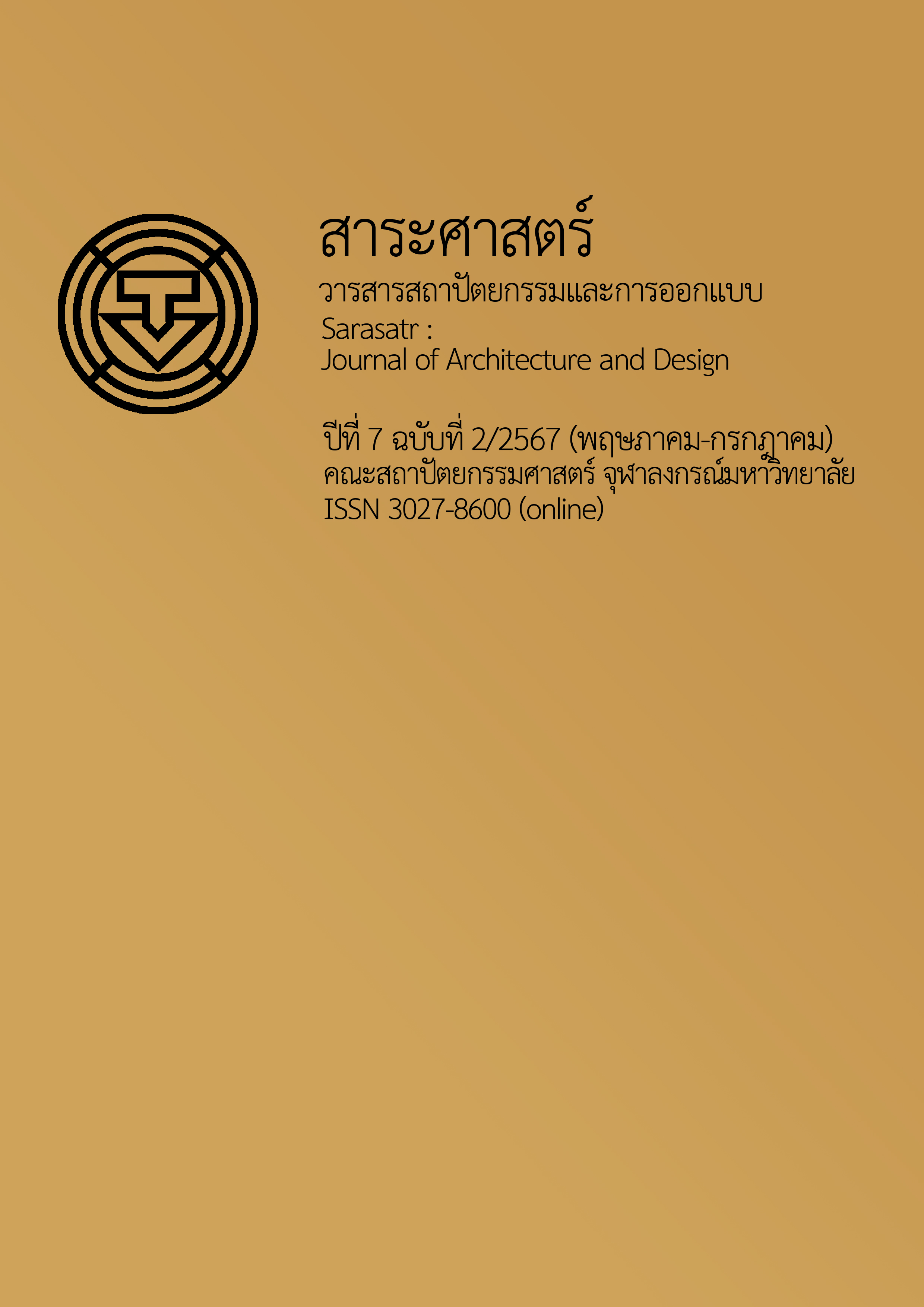แนวทางการจัดการสภาพแวดล้อมที่เอื้อต่อการเยียวยาของผู้ป่วยโรคซึมเศร้า กรณีศึกษาโรงพยาบาลศรีธัญญา
Main Article Content
บทคัดย่อ
สุขภาพจิตเป็นพื้นฐานของความเป็นอยู่ที่ดีและเกี่ยวข้องกับสภาวะจิตใจของบุคคล โดยโรคซึมเศร้าเป็นโรคที่มีความผิดปกติทางด้านอารมณ์ ซึ่งเป็นหนึ่งในปัญหาสุขภาพจิตที่มีอัตราเพิ่มขึ้นทุกปีในระดับประเทศและระดับโลก เป็นภัยเงียบของสุขภาพที่มีอิทธิพลต่อความสามารถในการทำงาน การดำเนินชีวิตประจำวันที่เกิดขึ้นได้ทุกเพศและทุกวัย โดยผู้ที่ป่วยระยะรุนแรงจะนำไปสู่การพยายามฆ่าตัวตาย โรคซึมเศร้าจำเป็นต้องมีการบำบัดรักษาจึงจะสามารถหายได้ ปัจจุบันการเข้ารับบริการของผู้ป่วยโรคซึมเศร้าถึงแม้ว่า ยังมีการเข้ารับบริการยังไม่ทั่วถึง แต่จำนวนผู้ป่วยสะสมในช่วง พ.ศ. 2559-2565 มีอัตราการเข้ารับบริการที่โรงพยาบาลเพิ่มขึ้นอย่างต่อเนื่อง โดยเฉลี่ยในปีหนึ่ง ๆ คิดเป็นร้อยละ 10.17 ของจำนวนผู้ป่วยโรคซึมเศร้าสะสมทั้งหมด จากการศึกษาพบว่า สภาพแวดล้อมภายในสถานพยาบาลสามารถเพิ่ม หรือลดความเจ็บปวดทางด้านจิตใจได้ จึงนำไปสู่การศึกษาแนวทางการจัดการสภาพแวดล้อมที่เอื้อต่อการเยียวยาผู้ป่วยโรคซึมเศร้าในโรงพยาบาลเฉพาะทางจิตเวช กรณีศึกษาโรงพยาบาลศรีธัญญา ที่มีวัตถุประสงค์เพื่อศึกษาพฤติกรรมและรูปแบบกิจกรรมของผู้ป่วยโรคซึมเศร้าที่มีความรุนแรงระยะเล็กน้อยและปานกลางต่อสภาพแวดล้อมเชิงกายภาพ เพื่อวิเคราะห์ปัญหา อุปสรรค และข้อจำกัดของสภาพแวดล้อมในโรงพยาบาลศรีธัญญา และเพื่อเสนอแนะแนวทางการพัฒนาและการจัดการพื้นที่เชิงกายภาพของโรงพยาบาลศรีธัญญา เพื่อนำไปสู่สภาพแวดล้อมที่เอื้อต่อการเยียวยาผู้ป่วยโรคซึมเศร้า โดยทำการเก็บข้อมูลจากการสำรวจและการสังเกตแบบไม่มีส่วนร่วมในบริเวณพื้นที่บำบัด และพื้นที่กิจกรรมของผู้ป่วยโรคซึมเศร้าส่วนผู้ป่วยนอก รวมถึงการสัมภาษณ์เจ้าหน้าที่ ผู้ดูแลผู้ป่วยโรคซึมเศร้าภายในโรงพยาบาลศรีธัญญา และผู้เชี่ยวชาญเฉพาะทางเพื่อหาข้อสรุปเชิงเสนอแนะ
ผลการศึกษาพบว่า ลักษณะทางกายภาพของพื้นที่บำบัด พื้นที่ส่วนกลาง และพื้นที่กิจกรรมบำบัด ส่วนผู้ป่วยนอกของโรงพยาบาลศรีธัญญามีข้อกำจัดและอุปสรรคต่อการบำบัดผู้ป่วยโรคซึมเศร้า ในประเด็นตำแหน่งการใช้งาน เสียงรบกวน แสงสว่างภายในพื้นที่ และความเป็นส่วนตัว เป็นต้น โดยสาเหตุมาจากการใช้พื้นที่อาคารเดิมที่ไม่ได้ออกแบบ หรือจัดการให้เอื้อต่อการบำบัดผู้ป่วยโรคซึมเศร้า
Article Details
เอกสารอ้างอิง
กรมสุขภาพจิต. (2562). โรคซึมเศร้า ทำใจพัง เช็กลิสต์สาเหตุและอาการ. https://dmh.go.th/news-dmh/view.asp?id=30114
กระทรวงสาธารณสุข. กรมอนามัย. สำนักอนามัยสิ่งแวดล้อม. (2557). คู่มือมาตรฐานการสุขาภิบาลและความปลอดภัยในโรงพยาบาล (พิมพ์ครั้งที่ 5). โรงพิมพ์สำนักงานพระพุทธศาสนาแห่งชาติ.
Krungsri GURU. (2564). คนใกล้ชิดป่วยเป็น "โรคซึมเศร้า" ควรดูแลเขาอย่างไร? https://www.krungsri.com/th/plearn-plearn/depression-do-dont/
โกศล จึงเสถียรทรัพย์, โกมาตร จึงเสถียรทรัพย์, พุทธชาติ แผนสมบุญ, และธนวรรณ สาระรัมย์. (2559). สถาปัตยกรรมโรงพยาบาลและสิ่งแวดล้อมเพื่อการเยียวยา. สำนักวิจัยสังคมและสุขภาพ-สำนักพิมพ์สุขศาลา.
พงศ์ภากร ศรธนะรัตน์. (2566). จิตใจกับความเจ็บปวดทางกาย.https://arunhealthgarden.com/mentalpain/5903/
มาโนช หล่อตระกูล. (2558). โรคซึมเศร้าโดยละเอียด. https://www.rama.mahidol.ac.th/ramamental/generalknowledge/general/09042014-1017
ศูนย์จิตรักษ์. (ม.ป.ป). กิจกรรมบำบัด ศูนย์จิตรักษ์ โรงพยาบาลกรุงเทพ. https://www.bangkokhospital.com/content/therapeutic-activities
สุวรรณา รัตนเสถียร. (2564). ศาสตร์และศิลป์อโรมาเทอราปีคลายเครียดลดอาการซึมเศร้า. https://dmh.go.th/news/view.asp?id=2452
อภันตรี สาขากร. (ม.ป.ป.). จิตบำบัดรักษาโรคซึมเศร้าได้อย่างไร.https://www.manarom.com/blog/Psychotherapy_with_depression.html
Bechtel, R. B., Marans, R. W., & Michelson, W. (1987). Methods in environmental and behavioral research. Van Nostrand Reinhold.
Brymer, E., & Davids, K. (2014). Experiential learning as a constraint-led process: An ecological dynamics perspective. Journal of Adventure Education and Outdoor Learning, 14(2), 103–117.
Jefferson Health Cherry Hill Hospital Expansion, CallisonRTKL (Washington, D.C.). (2021, July 16). https://healthcaredesignmagazine.com/featured-firms-projects/jefferson-health-cherry-hill-hospital-expansion/#slide-5
JMIR Ment Health. (2019). Patient privacy perspectives on health information exchange in a mental health context: Qualitative study. https://www.ncbi.nlm.nih.gov/pmc/articles/PMC6881785/
Juby, B. (2022). Are certain colors linked to depression? https://psychcentral.com/depression/decreased-perception-of-color-in-depression#color- perception
Komulainen, K., Hakulinen, C., Lipsanen, J., Partonen, T., Pulkki-Råback, L., Kähönen,M., Virtanen, M., Ruuhela, R., Raitakari, O., & Elovainio, M. (2022). Associations of long-term solar insolation with specific depressive symptoms: Evidence from a prospective cohort study. Journal of Psychiatric Research, 151, 606-610. https://doi.org/10.1016/j.jpsychires. 2022.05
Miles, M. B., & Huberman, A. M. (1994). Qualitative data analysis: An expanded sourcebook (2nd ed.). Thousand Oaks.
Nastasi, B. K., & Schensul, S. L. (2005). Contributions of qualitative research to the validity of intervention research. Journal of School Psychology, 43(3), 177-195.
Rautio, N., Filatova, S., Lehtiniemi, H., & Miettunen, J. (2017). Living environment and its relationship to depressive mood: A systematic review. International Journal of Social Psychiatry, 64(1), 92-103.
United Family Healthcare, Shanghai. (n.d.). Designing the heart of a healing environment. https://www.mmoser.com/projects/united-family-healthcare-shanghai/
Ulrich, R. S. (2001). Effects of healthcare environmental design on medical outcomes. In A. Dalani (Ed.), Design and health: The therapeutic benefits of design (pp. 49-59). Svenskbyggtjänst.


